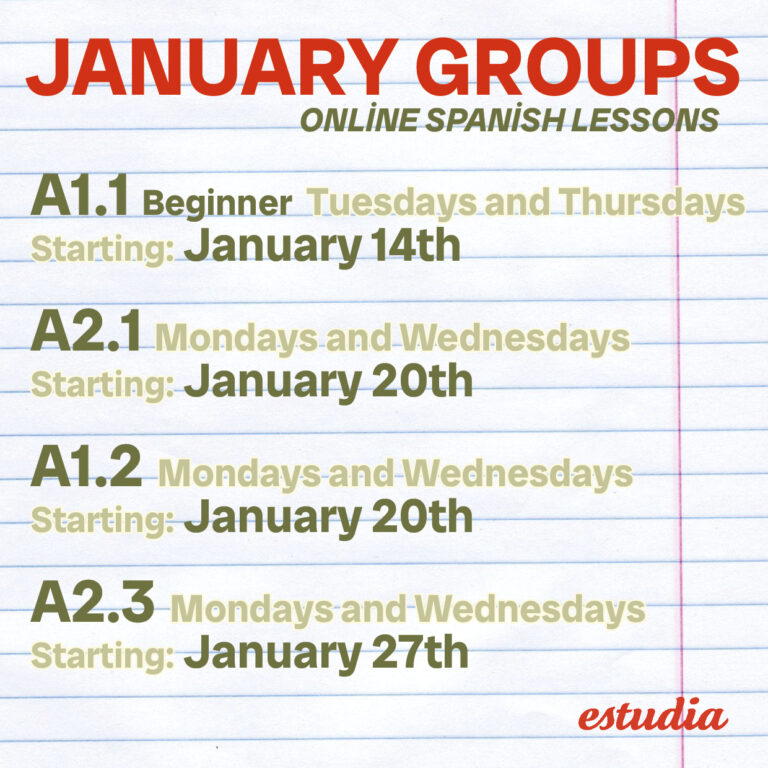The Conjugation of the Simple Present Indicative in Spanish: Regular Verbs
The simple present indicative is one of the most important tenses in Spanish, as it’s used to talk about habitual actions, general facts, and permanent situations. Below, we explain its conjugation for regular verbs, structured in 8 points to help you master this tense.
1. Regular Verbs Ending in -AR
Regular verbs ending in -AR follow a simple conjugation pattern in the present indicative. To conjugate them, remove the “-ar” ending and add the following endings: -o, -as, -a, -amos, -áis, -an.
Example: Hablar (to speak)
- Yo hablo (I speak)
- Tú hablas (You speak)
- Él/Ella/Usted habla (He/She/You formal speak)
- Nosotros/Nosotras hablamos (We speak)
- Vosotros/Vosotras habláis (You all speak)
- Ellos/Ellas/Ustedes hablan (They/You all speak)
2. Regular Verbs Ending in -ER
Regular verbs ending in -ER are conjugated by removing the “-er” ending and adding: -o, -es, -e, -emos, -éis, -en.
Example: Comer (to eat)
- Yo como (I eat)
- Tú comes (You eat)
- Él/Ella/Usted come (He/She/You formal eat)
- Nosotros/Nosotras comemos (We eat)
- Vosotros/Vosotras coméis (You all eat)
- Ellos/Ellas/Ustedes comen (They/You all eat)
3. Regular Verbs Ending in -IR
Regular verbs ending in -IR are conjugated similarly to -ER verbs, with some differences in the endings: -o, -es, -e, -imos, -ís, -en.
Example: Vivir (to live)
- Yo vivo (I live)
- Tú vives (You live)
- Él/Ella/Usted vive (He/She/You formal live)
- Nosotros/Nosotras vivimos (We live)
- Vosotros/Vosotras vivís (You all live)
- Ellos/Ellas/Ustedes viven (They/You all live)
4. Usage of the Simple Present
The simple present is used to describe habitual actions, general facts, or universal truths. It is useful for talking about daily routines or events that happen regularly.
Examples:
- “Yo estudio español todos los días.” (I study Spanish every day.)
- “El sol sale por el este.” (The sun rises in the east.)
5. Negation in the Simple Present
To negate in the simple present, simply place the word “no” before the conjugated verb.
Examples:
- “Yo no hablo francés.” (I do not speak French.)
- “Ellos no comen carne.” (They do not eat meat.)
6. Questions in the Simple Present
To form questions in the simple present, invert the order of the subject and the verb, or use a question word at the beginning.
Examples:
- “¿Hablas inglés?” (Do you speak English?)
- “¿Dónde vives?” (Where do you live?)
7. Special Forms of “Vosotros” and “Ustedes”
In Spain, “vosotros” is used to address a group of people in an informal context. In Latin America, “ustedes” is more common and is used in both formal and informal contexts.
Examples:
- Spain: “¿Vosotros habláis español?” (Do you all speak Spanish?)
- Latin America: “¿Ustedes hablan español?” (Do you all speak Spanish?)
8. Common Mistakes in Conjugation
One of the most common mistakes is confusing the endings of -ER and -IR verbs, especially in the first person plural. Remember: “nosotros comemos” (ER) and “nosotros vivimos” (IR). Practicing these differences is key to correct conjugation.
Correct Examples:
- “Nosotros comemos pizza.” (We eat pizza.)
- “Nosotros vivimos en Madrid.” (We live in Madrid.)
9. Irregular verbs in the present indicative
Irregular verbs in the present indicative are those that do not follow the general conjugation rules. Instead of changing according to the regular verb patterns (-ar, -er, -ir), they show alterations in their stems or endings. These verbs can be divided into several groups based on the type of irregularity they exhibit:
- Stem-changing verbs (e > ie, o > ue, e > i):
- Example: pensar (yo pienso, tú piensas…)
- Example: dormir (yo duermo, tú duermes…)
- Example: pedir (yo pido, tú pides…)
- Verbs with an irregular first-person form:
In these verbs, only the “yo” (I) form is irregular.- Example: hacer (yo hago, tú haces…)
- Verbs with a stem change in the first-person singular while the rest of the conjugation follows a regular pattern:
- Example: tener (yo tengo, tú tienes…)
- Verbs with spelling changes:
To maintain the sound, some verbs change their spelling in the first-person singular.- Example: conocer (yo conozco, tú conoces…)
Now that you know the basics of conjugating the simple present in Spanish, it’s time to practice! At Estudia, we offer online Spanish classes, both private and group, tailored to your needs. Contact us today to improve your Spanish and find the perfect course for you or your company. Your journey to Spanish fluency starts here!





